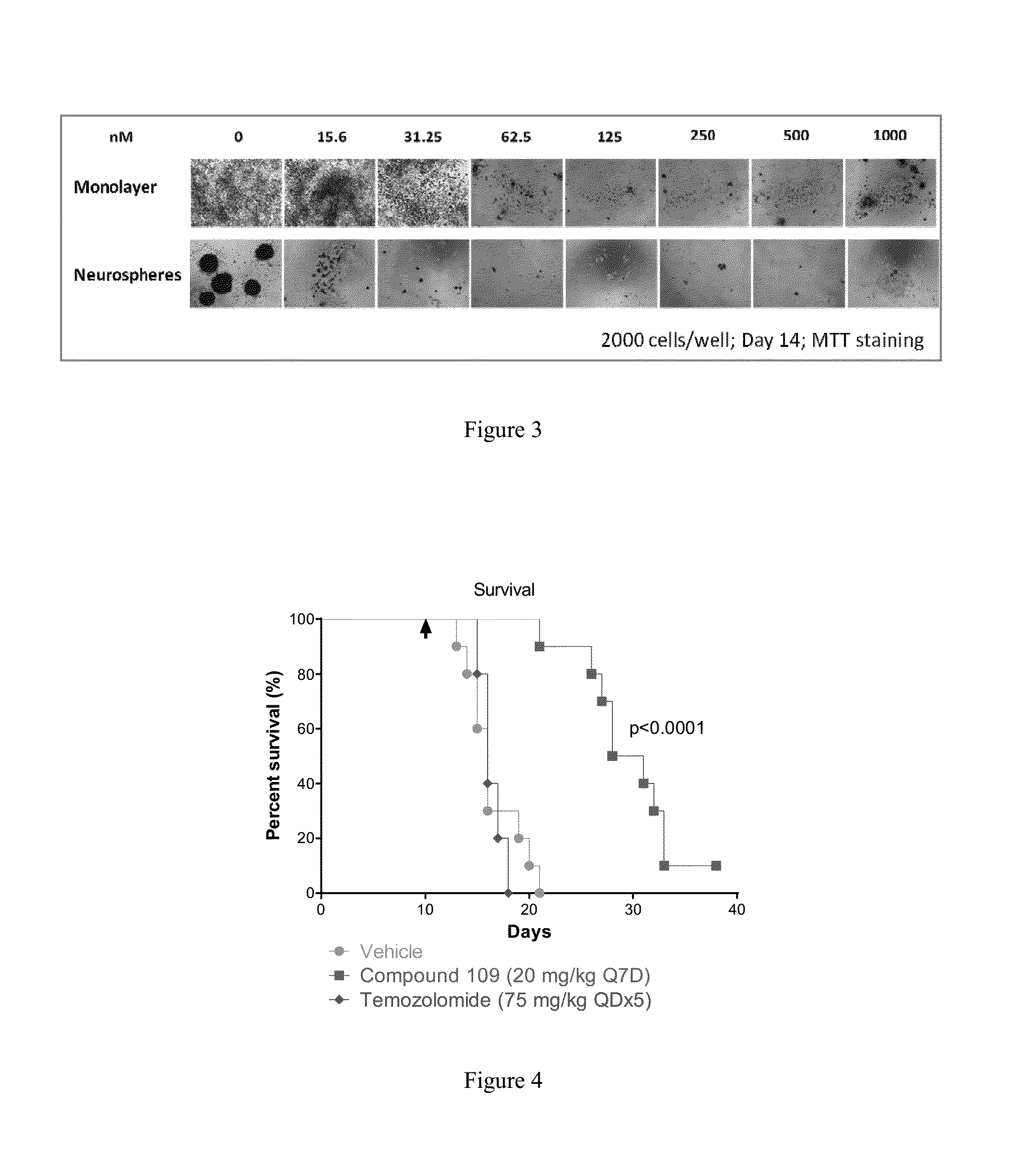Substituted reverse pyrimidine bmi-1 inhibitors
a technology of reverse pyrimidine and inhibitor, which is applied in the direction of biocide, drug composition, therapy, etc., can solve the problems of traditional drug discovery methods targeting bmi-1, and achieve the effect of reducing the level of bmi-1
- Summary
- Abstract
- Description
- Claims
- Application Information
AI Technical Summary
Benefits of technology
Problems solved by technology
Method used
Image
Examples
example 4
5-fluoro-N-(4-methylphenyl)-2-[2-(trifluoromethyl)imidazo[1,2-a]pyridin-3-yl]pyrimidin-4-amine (Cpd 43)
[0401]
[0402]Step1: A mixture of 2,4-dichloro-5-fluoropyrimidine (1.00 g, 5.99 mmol), 4-toluidine (642 mg, 5.99 mmol) and K2CO3 (1.66 g, 12.0 mmol) in EtOH (10 mL) was stirred for 18 hours at 50° C. The mixture was filtered through Celite and purified by column chromatography to yield 2-chloro-5-fluoro-N-p-tolylpyrimidin-4-amine (1.19 g, 84%).
[0403]Step2: A mixture of 2-chloro-5-fluoro-N-p-tolylpyrimidin-4-amine (165 mg, 0.69 mmol), 3-(tributylstannyl)-2-(trifluoromethyl)imidazo[1,2-a]pyridine (300 mg, 0.63 mmol), Q-Phos (13.5 mg, 0.019 mmol) and PdCl2(allyl) (6.9 mg, 0.019 mmol) in dioxane (1.5 mL) was stirred for 2 hours at 90° C. The mixture was purified by column chromatography to yield the title compound (213 mg, 80%).
[0404]1H NMR (500 MHz, CHLOROFORM-d) δ ppm 9.24-9.29 (1H, m) 8.29 (1H, d, J=2.84 Hz) 7.66-7.71 (1H, m) 7.46 (2H, d, J=8.51 Hz) 7.31 (1H, ddd, J=9.14, 6.62, 1.26 H...
example 5
2-(6-fluoro-2-methylimidazo[1,2-a]pyridin-3-yl)-N-[4-(trifluoromethyl)phenyl]pyrimidine-4,6-diamine (Cpd 68)
[0406]
[0407]Step 1. A mixture of 2,6-dichloropyrimidine-4-amine (3.78 g, 23.05 mmol) and DMAP (cat.) in dichloromethane (20 mL) was treated with di-tert-butyldicarbonate (11.05 g, 50.71 mmol) at 0° C. After addition, the resulting mixture was stirred at ambient temperature overnight. The mixture was poured into ice-water (120 mL) and extracted with dichloromethane (150 mL). The organic phase was separated, washed with brine (100 mL), dried over MgSO4, then filtered and evaporated. The residual material was separated by filtering through a pad of silica gel (100 g) to afford di-tert-butyl (2,6-dichloropyrimidin-4-yl)imidodicarbonate as an oil (7.55 g, 90%).
[0408]Step 2. A solution of di-tert-butyl (2,6-dichloropyrimidin-4-yl)imidodicarbonate (1.75 g, 4.81 mmol) and 4-trifluoromethylaniline (775.0 mg, 4.81 mmol) in THF (10 mL) was treated with potassium tert-butoxide solution (1...
example 6
2-(6-fluoro-2-methyl-1H-benzimidazol-1-yl)-N-[4-(trifluoromethyl)phenyl]pyrimidine-4,6-diamine (Cpd 71)
[0415]
[0416]Step 1: A mixture of 5-fluoro-2-nitroaniline (156.2 mg, 1.00 mmol), di-tert-butyl 2-chloro-6-(4-(trifluoromethyl)phenylamino)pyrimidin-4-yliminodicarbonate (480.0 mg, 0.98 mmol), 2-dicyclohexylphosphino-2′,4′,6′-triisopropylbiphenyl (Xphos) (56.1 mg, 0.1 mmol), tris(dibenzylideneacetone) dipalladium(0) (53.8 mg, 0.05 mmol) and potassium phosphate (625.0 mg, 2.95 mmol) in dioxane (2 mL) was degassed by three cycles of vacuum pumping and N2 purging, and then was heated to 100° C. for 2 hours. The solution was cooled and poured into water (10 mL), and this mixture was extracted with ethyl acetate (15 mL). The extract was dried over MgSO4, then filtered and evaporated. The residual material was separated by column chromatography (eluting with 1:1 dichloromethane:hexane, then 1:2 ethyl acetate:dichloromethane) to afford di-tert-butyl 2-(5-fluoro-2-nitrophenylamino)-6-(4-(tri...
PUM
| Property | Measurement | Unit |
|---|---|---|
| weight | aaaaa | aaaaa |
| weight | aaaaa | aaaaa |
| weight | aaaaa | aaaaa |
Abstract
Description
Claims
Application Information
 Login to View More
Login to View More - Generate Ideas
- Intellectual Property
- Life Sciences
- Materials
- Tech Scout
- Unparalleled Data Quality
- Higher Quality Content
- 60% Fewer Hallucinations
Browse by: Latest US Patents, China's latest patents, Technical Efficacy Thesaurus, Application Domain, Technology Topic, Popular Technical Reports.
© 2025 PatSnap. All rights reserved.Legal|Privacy policy|Modern Slavery Act Transparency Statement|Sitemap|About US| Contact US: help@patsnap.com



